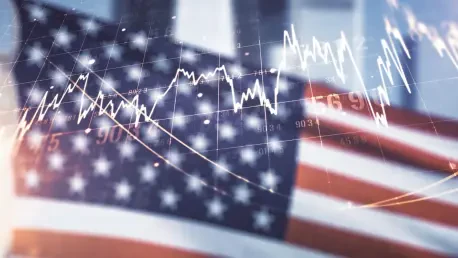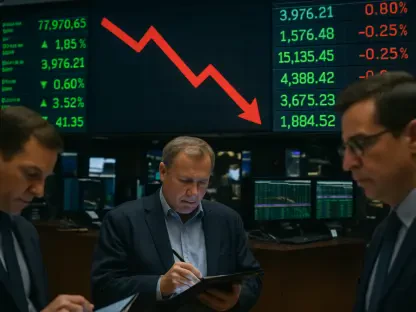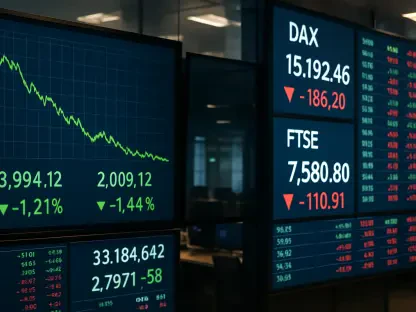In a remarkable turn of events, US stock markets received a significant boost driven by diplomatic and technological advancements orchestrated by the previous administration. The framework announcement for a trade deal between the United States and the United Kingdom has sparked investor enthusiasm, marking a historic milestone in transatlantic economic collaboration. Furthermore, the reversal of restrictive measures on AI chip exports initially imposed under a different administration has reinvigorated the tech sector. Both these moves have infused new energy into the markets, signaling vital strides in both trade and technological innovation.
Trade Developments Revitalize Confidence
Framework of the US-UK Trade Agreement
The recent announcement of a tentative trade agreement between the US and the UK has captured the financial community’s attention, showcasing efforts to rebuild and strengthen trade relations. President Trump conveyed the news via a post on his social media platform, Truth Social, outlining the preliminary framework of the deal. This agreement aims to reinforce long-standing economic ties, with a strong focus on expanding market access for US exports. Strategically, the emphasis is being placed on the agricultural sector, which has felt the brunt of the tariffs previously enacted by the administration. By alleviating uncertainty surrounding tariffs, the agreement’s announcement was immediately received with optimism by investors, reflecting a sense of stability and forward momentum.
Anticipation surrounding further trade deals with other major economies added to the excitement in financial markets. The early indications of increased exports, alongside potential reductions in trade barriers, fueled the belief that both the US and UK could benefit immensely from mutual cooperation. Investors now look forward to more developments in these deals, which are anticipated to have significant implications for international trade dynamics. However, intricacies such as the ongoing trade negotiations with China remain a focal point, bearing the potential to significantly alter the landscape depending on their outcomes.
Economic Impact and Financial Markets
As financial markets reacted to the US-UK trade agreement news, major indices such as the Dow Jones Industrial Average, S&P 500, and the Nasdaq Composite recorded substantial gains. This rally can largely be attributed to a renewed sense of optimism regarding prospects for economic growth resulting from improved trade relations. The market’s positive response serves as an indication of investor confidence in the administration’s ability to mitigate previous trade tensions and open new avenues for economic expansion.
Commerce Secretary Howard Lutnick noted in public statements that the UK would still be subject to Trump’s 10% universal tariff, but the 90-day waiver currently in place allows for extended discussions and possible adjustments. This easing of tariffs lays the groundwork for stronger bilateral links, encouraging businesses and market players to approach the new trade environment proactively. However, despite these encouraging signs, stakeholders remain watchful, particularly regarding the next steps in trade negotiations with key global players such as China, whose outcome could potentially reshape trading synergies and economic stability.
Technological Advancements and Market Dynamics
Reversal of AI Chip Export Restrictions
In addition to the trade agreement’s positive reception, the tech sector has experienced a noteworthy uptick due to policy changes relating to AI chip exports. Initially enforced under President Biden, export restrictions on AI chips faced significant backlash from industry leaders. These critics argued that limiting American companies’ capabilities to export advanced technologies not only stymied US innovation but also left them at a disadvantage against global competitors.
The decision by the US Commerce Department to roll back these restrictions has prompted a bullish rally in technology stocks. Chip manufacturers like Intel, Broadcom, and Nvidia have seen a notable increase in their stock prices. This policy change is widely regarded as a move toward fostering technological advancements and bolstering the country’s position in the global tech arena, mirroring actions taken to support infrastructure and address the national trade deficit. By aligning its policies with the industry’s interests, the administration has set the stage for significant growth in high-paying jobs and technological innovation within the US. Investors are closely monitoring these developments, which are poised to have a lasting impact on the nation’s economic trajectory and technological prominence.
Implications for the Tech Industry
The tech sector’s reaction to the reversal of AI chip export restrictions was swift, resulting in an immediate and noticeable appreciation in the shares of leading chipmakers. The policy shift represents a positive direction for the sector, encouraging innovation and technological progression. Companies such as Advanced Micro Devices, Intel, Nvidia, and Broadcom, which had been recalibrating their strategies in response to earlier restrictions, are now positioned for expanded opportunities.
These developments have also drawn attention to the broader implications for the US job market. As the tech industry experiences growth, high-demand roles in engineering, research, and development are anticipated to arise, offering lucrative opportunities to professionals in the field. Furthermore, the policy change aligns with strategic priorities to boost domestic manufacturing capabilities, creating a ripple effect across various sectors of the economy. Investors remain vigilant in tracking the unfolding scenario and its impact on broader economic policies, including the interest rate trajectory and fiscal decisions.
Balancing Trade Policies and Economic Stability
Interplay Between Trade and Monetary Policies
As the US explores new pathways in both trade and technology, the interplay between these sectors and monetary policy remains critical. The administration’s actions have stirred discussions around the Federal Reserve’s current stance on interest rates. Despite President Trump’s calls for rate cuts, the Federal Reserve has opted to maintain rates, cautioning against potential stagflation scenarios, which involve high inflation rates alongside sluggish economic growth.
Federal Reserve Chairman Jerome Powell’s observations reflected concerns over tariffs driving up inflation while reducing the purchasing power of consumers. These factors complicate the Federal Reserve’s dual mandate of achieving price stability and maximum employment. Investors are keenly observing these decision-making processes, whereby the Federal Reserve seeks a balanced approach to preserve both economic stability and growth.
Market Reactions and Future Considerations
In an unexpected twist, US stock markets experienced a noteworthy upswing fueled by diplomatic and technological advances initiated by the previous administration. The announcement of a new framework for establishing a trade deal between the United States and the United Kingdom has stirred investor excitement, marking a significant achievement in transatlantic economic cooperation. This agreement highlights a promising era of collaboration, likely leading to increased economic growth and mutual investment opportunities. In addition, the lifting of former restrictions on AI chip exports has revitalized the tech industry. These constraints were originally imposed by a different administration, but their reversal has reignited innovation and allowed businesses in the sector to expand global reach. Both of these strategic moves have injected fresh vigor into the markets, indicating crucial developments in trade and technological progress, setting the stage for a dynamic future ahead.









